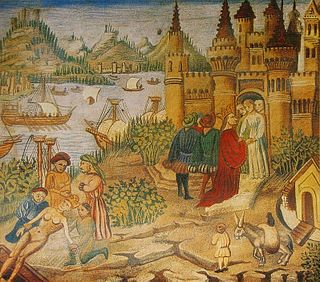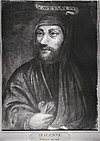
Ibn Sina, commonly known in the West as Avicenna, was a preeminent philosopher and physician of the Muslim world, flourishing during the Islamic Golden Age, serving in the courts of various Iranian rulers. He is often described as the father of early modern medicine. His philosophy was of the Muslim Peripatetic school derived from Aristotelianism.

Esther, originally Hadassah, is the eponymous heroine of the Book of Esther in the Hebrew Bible. According to the biblical narrative, which is set in the Achaemenid Empire, the Persian king Ahasuerus falls in love with Esther and marries her. His grand vizier Haman is offended by Esther's cousin and guardian Mordecai because of his refusal to bow before him; bowing in front of another person was a prominent gesture of respect in Persian society, but deemed unacceptable by Mordecai, who believes that a Jew should only express submissiveness to God. Consequently, Haman plots to have all of Persia's Jews killed, and eventually convinces Ahasuerus to permit him to do so. However, Esther foils the plan by revealing and decrying Haman's plans to Ahasuerus, who then has Haman executed and grants permission to the Jews to take up arms against their enemies; Esther is hailed for her courage and for working to save the Jewish nation from eradication.

Japheth is one of the three sons of Noah in the Book of Genesis, in which he plays a role in the story of Noah's drunkenness and the curse of Ham, and subsequently in the Table of Nations as the ancestor of the peoples of the Aegean Sea, Anatolia, Caucasus, Greece, and elsewhere in Eurasia. In medieval and early modern European tradition he was considered to be the progenitor of the European peoples.

Daniel Deronda is a novel written by English author George Eliot, first published in eight parts (books) February to September 1876. It was the last novel she completed and the only one set in the Victorian society of her day. The work's mixture of social satire and moral searching, along with its sympathetic rendering of Jewish proto-Zionist ideas, has made it the controversial final statement of one of the most renowned Victorian novelists.

The tradition of humor in Judaism dates back to the compilation of the Torah and the Midrash in the ancient Middle East, but the most famous form of Jewish humor consists of the more recent stream of verbal and frequently anecdotal humor of Ashkenazi Jews which took root in the United States during the last one hundred years, it even took root in secular Jewish culture. In its early form, European Jewish humor was developed in the Jewish community of the Holy Roman Empire, with theological satire becoming a traditional way to clandestinely express opposition to Christianization.

The Schola Medica Salernitana was a medieval medical school, the first and most important of its kind. Situated on the Tyrrhenian Sea in the south Italian city of Salerno, it was founded in the 9th century and rose to prominence in the 10th century, becoming the most important source of medical knowledge in Western Europe at the time.

Persian Jews or Iranian Jews constitute one of the oldest communities of the Jewish diaspora. Dating back to the biblical era, they originate from the Jews who relocated to Iran during the time of the Achaemenid Persian Empire. Books of the Hebrew Bible bring together an extensive narrative shedding light on contemporary Jewish life experiences in ancient Persia; there has been a continuous Jewish presence in Iran since at least the time of Cyrus the Great, who led the Persian army's conquest of the Neo-Babylonian Empire and subsequently freed the Judahites from the Babylonian captivity.

Burhan-ud-Din Kermani or Burhān al-Din Nafīs ibn ‘Iwad al-Kirmanī was a 15th-century Persian physician from Kerman. He was court physician to Ulugh Beg, the grandson of Tamerlane and the governor of Samarqand from 1409 to 1449.

The Spanish Benveniste family is an old, noble, wealthy, and scholarly Jewish family of Narbonne, France and northern Spain established in the 11th century. The family was present in the 11th to the 15th centuries in Hachmei Provence, France, Barcelona, Aragon and Castile.

ʿAlāʾ al-Dīn Abū al-Ḥasan ʿAlī ibn Abī Ḥazm al-Qarashī, known as Ibn al-Nafīs, was an Arab polymath whose areas of work included medicine, surgery, physiology, anatomy, biology, Islamic studies, jurisprudence, and philosophy. He is known for being the first to describe the pulmonary circulation of the blood. The work of Ibn al-Nafis regarding the right sided (pulmonary) circulation pre-dates the later work (1628) of William Harvey's De motu cordis. Both theories attempt to explain circulation. 2nd century Greek physician Galen's theory about the physiology of the circulatory system remained unchallenged until the works of Ibn al-Nafis, for which he has been described as "the father of circulatory physiology".
Saʿd al-Dawla ibn Ṣafī ibn Hibatullāh ibn Muhassib al-Dawla al-Abharī was a Jewish physician and statesman in thirteenth-century Persia (Iran).

The history of the Jews in Iran dates back to late biblical times. The biblical books of Chronicles, Isaiah, Daniel, Ezra, Nehemiah, contain references to the life and experiences of Jews in Persia. In the book of Ezra, the Persian kings are credited with permitting and enabling the Jews to return to Jerusalem and rebuild their Temple; its reconstruction was carried out "according to the decree of Cyrus, and Darius, and Artaxerxes king of Persia". This great event in Jewish history took place in the late 6th century BCE, by which time there was a well-established and influential Jewish community in Persia.
The Allahdad was an 1839 pogrom perpetrated by Muslims against the Mashhadi Jewish community in the city of Mashhad, Qajar Iran. It was characterized by the mass-killing and forced conversion of the Jews in the area to Islam. Following this event, many of the Mashhadi Jews began to actively practice crypto-Judaism while superficially adhering to Islamic beliefs. The Allahdad incident was a prominent event in the ambivalent history of Jewish–Muslim relations because an entire community of Jews were forced to convert, and it was one of the first times European Jewry intervened on behalf of Iranian Jews.

The practice and study of medicine in Persia has a long and prolific history. The Iranian academic centers like Gundeshapur University were a breeding ground for the union among great scientists from different civilizations. These centers successfully followed their predecessors’ theories and greatly extended their scientific research through history. Persians were the first establishers of modern hospital system.
Cyril Lloyd Elgood M.D., F.R.C.P., honorary physician to the king of Persia (Shah) (1893–1970) commonly referred to as Cyril Elgood was a British physician and historian of medicine in Persia/Iran, best remembered for his breakthrough studies on the history of medical and educational advances of Persia during the period of the 1500s to mid 18th century. He was also known for his work at Her Britannic Majesty's embassy in Tehran, his service in the British army in British India starting in 1914, and his active role in quarantine facilitation during infectious disease outbreaks in south-west Iran.

The Physician is a 2013 German historical drama film based on the novel of the same name by Noah Gordon. The film, co-written and directed by Philipp Stölzl, focuses on an orphan from an 11th-century English town whose mother died of side sickness. The boy vows to study medicine and decides to travel to Persia.
El médico is a Spanish musical based on the novel of the same name by Noah Gordon, with book and lyrics by Félix Amador, and music by Iván Macías. Its central plot revolves around Rob J. Cole, a young orphan in 11th-century England who has an unusual gift: he can predict death with his hands. Taken in as an apprentice by a traveling barber surgeon, the boy travels across the country discovering the trade and the secrets of the profession. When at the age of 19 he hears of Avicena and her medical school in far away Persia, Rob sets off into the unknown to travel halfway across the world and become a doctor.














